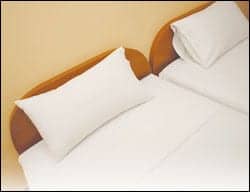 |
The Cochrane Collaboration recently concluded that, “The relative merits of higher-tech constant low pressure and alternating pressure for prevention [of pressure ulcers] are unclear.”1 It also recommends that “consideration should be given to the use of higher specification foam mattresses rather than standard hospital foam mattresses.”1 While these conclusions do provide some direction, therapists are left to wonder which surface would be “best” for their clients.
It is clear that most therapeutic support surfaces perform better than standard hospital mattresses.1 While research on higher-tech devices such as low-air-loss and alternating air mattresses has been published, many of these studies compare these devices to standard hospital mattresses, so evidence of efficacy is not unexpected. In addition, many studies report on interface pressure rather than a clinical outcome such as rate of pressure ulcer development.
Support surfaces have been defined as “static” and “dynamic,” and prescription criteria have been developed using this classification. The National Pressure Ulcer Advisory Panel has recently changed the terminology regarding therapeutic support surfaces.2 Rather than classifying them as “static” and “dynamic,” they are now classified as follows:
Reactive Support Surface: a powered or nonpowered support surface with the capability to change its load distribution properties only in response to applied load.2
Active Support Surface: a powered support surface with the capability to change its load distribution properties with or without applied load.2
The classifications of static and dynamic used in the past do not match the new classifications, so prescription criteria—based on the old classifications—also will need to change. In light of these perspectives, therapists must find other ways of determining the best mattress for their client rather than focusing solely on pressure management.
A primary consideration is ease of use. Surfaces that are not set up appropriately or adequately maintained will not provide adequate pressure management for clients. If caregiver burden is high, or staff members in a facility perceive that they don’t have time to provide adequate care, adding a piece of equipment that is perceived as “complicated” may result in improper use. Keeping the device simple, and/or setting up a process for monitoring and maintaining the surface, will help to decrease impact on the caregiver.
The client’s goals and overall care plan also are of utmost importance. The therapist involved with the client can assess pressure ulcer risk, bed mobility, transfers, posture and positioning, and financial resources. The environment where the client sleeps—physical space, access to an appropriate electrical outlet, reliability of the power supply—also will impact the choice of features. Assessment findings in each of these areas will help therapists and providers determine which features may be most appropriate.
Providng situation-appropriate education is vitally important so that clients can participate in the decisions about which surface would be the best. Clients who actively participate in these decisions are more likely to use that device in the way it was intended. Education should focus on the risk factors for pressure ulcers, the client’s specific issues, and the benefits/features and disadvantages of the therapeutic support surfaces available.
Read more about finding appropriate beds and surfaces by searching our free online archives.
For example, when selecting beds and surfaces for the bariatric client, certain protocols should be followed to address the individual’s needs—from edema and pressure sore prevention and care to therapeutic benefits and comfort needs. An additional consideration when selecting a bariatric bed is meeting the needs of caregivers—who will be moving and caring for their charges alone in a home care environment.
Each member of the team, the client, the therapist, and the home medical equipment provider, brings unique skills and knowledge to the support-surface selection process. Clients understand how surfaces will impact their lifestyle and whether they will be used. The therapist has the clinical information, while the home medical equipment provider knows about the best and most up-to-date products available. Working together, they can determine the “best” surface for the client.
 |
Linda Norton, OT, is rehabilitation education coordinator for a home medical equipment provider in Ontario, Canada. Norton has presented workshops across North America on seating and mobility and pressure ulcer management. She can be reached via e-mail:
References
- Cullum N, McInnes E, Bell-Syer SEM, Legood R. Support surfaces for pressure ulcer prevention. Cochrane Library. 2006(4).
- National Pressure Ulcer Advisory Panel. Available at: www.npuap.org. Accessed January 14, 2007.



